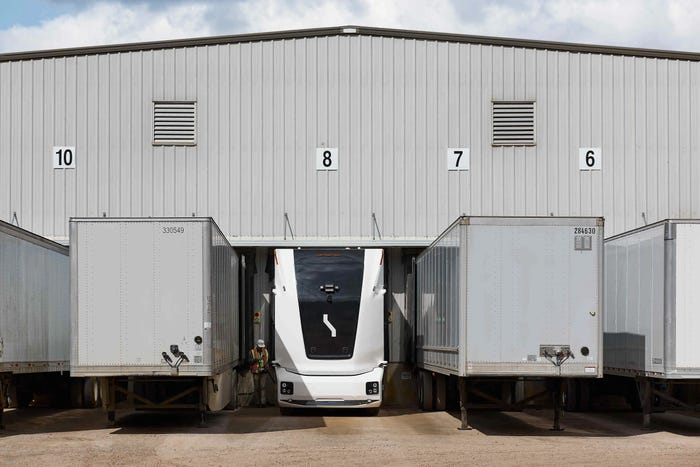GE Uses Cabinless Self-Driving Trucks for DeliveriesGE Uses Cabinless Self-Driving Trucks for Deliveries
Einride's cabinless truck uses cameras, lidar and radar sensors for its self-driving functionality and is remotely monitored

Swedish company Einride’s distinctive unmanned cabinless truck is now performing regular commercial deliveries for GE Appliances (GEA).
The deployment marks the latest stage in the blossoming relationship between the two firms.
Last year, Einride and GEA successfully completed the first pilot of an electric autonomous heavy-duty vehicle without a driver on board on public roads in the United States. The groundbreaking pilot operated out of the latter’s facility in Selmer, Tennessee.
That followed trials on predetermined routes behind closed doors at GEA’s headquarters in Louisville, Kentucky in 2021.
The success of these programs has prompted the companies to step activities up at Selmer, and the futuristic autonomous vehicle (AV) is now moving finished goods between the GEA plant to a warehouse 0.3 miles away, making up to seven trips along a privately owned road daily between Mondays and Thursdays.
The truck, which has been designed from the ground up to be driverless, does without traditional controls, such as pedals and a steering wheel, for a very simple reason – there is no cabin.

Instead, it relies on cameras, lidar and radar sensors, for its self-driving functionality, plus is monitored by Einride’s first remote operator, Tiffany Heathcott, who makes sure there are no interruptions to the vehicle’s progress. Connectivity is provided on a private network provided by Ericsson.
Although Heathcott is based in Selmer for now, the tech does not require remote operators to be on-site, and in the future, they will be located further away.
At this early stage, speeds are modest, with the truck traveling at around 3 mph on a specially constructed lane. The GEA-owned road is open to other vehicles, but traffic is light.
The AV deployment is part of a wider program at Selmer to create an automated logistics flow. In the loading bay, AI cameras from another GEA partner, Ohio-based TaskWatch, trigger a control board to raise and lower the dock doors and dock plate and lock the truck in place. Then a robot from a third partner, Atlanta’s Slip Robotics, autonomously loads and unloads the vehicle, reducing loading times by 80%.
“We are very proud to partner with GEA and be able to lead the industry in providing autonomous technology and deploying it in the strongest commercial use case today,” said Henrik Green, general manager at Einride. “We look forward to continuing this work to establish autonomous’ key role in transportation, both with GEA and other partners across markets.”
Harry Chase, senior director at GEA, added: “We are moving from implementing one-off solutions addressing various challenges to creating interoperability among systems that can build consistency and streamline processes in our factories and throughout our supply chain.
“This implementation in Selmer is helping us reduce emissions, allowing our employees to focus on high-value tasks, reducing traffic in congested areas to create a safer work environment and eliminating some of the most challenging ergonomic tasks.”
About the Author
You May Also Like








